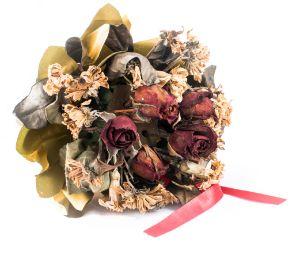Biedermeier Bouquet
Post from EditorialsThe Biedermeier is a decorative technique that was born in Austria in the last century, with this technique, you can make beautiful and refined items. Here is how to make a bouquet.

Origins of the Biedermeier
The Biedermeier is one of the oldest decorative techniques, after the most famous decoupage, of course!
It consists in the realization of decorations by using dried flowers, fabric and colored ribbons: in fact the term is attributed to a larger artistic movement, concerning furnishings and decorative arts, which developed mainly in Germany and Austria between 1815 and 1848. Smooth surfaces, massive proportions, clean lines are the main features of this style, often opposed to the Empire style, much appreciated by the bourgeoisie of the time for its functionality.
Smooth surfaces, massive proportions, clean lines are the main features of this style, often opposed to the Empire style, much appreciated by the bourgeoisie of the time for its functionality.
To the almost excessive use of decorative elements typical of the latter, the Biedermeier style contrasts with a decorative simplicity furnishings visible in representative pieces of fornitures of this movement such as the display cabinet and the secretaire.
As for the decorative technique, it is possible to make products beautiful and elegant and give to the spaces of your house a touch of retro: the most common elements are made with Biedermeier bouquet, let's discover together how to make one.
Equipment for the Biedermeier
 The Biedermeier is a particularly complex technique, nothing to do with the simplicity and immediacy of stencils and decoupage: the intent of this article, therefore, is to stimulate your curiosity about the subject.
The Biedermeier is a particularly complex technique, nothing to do with the simplicity and immediacy of stencils and decoupage: the intent of this article, therefore, is to stimulate your curiosity about the subject.
With this procedure you can also make more complex work including the famous Christmas wreaths, candle holders as the one in the picture, fragrant baskets or decorations to put on boxes or jewelry.
As mentioned previously, the compositions Biedermeier can be identified by the combined use of dried flowers combined with spices - such as star anise, cloves - dried citrus slices, ribbons and fabrics, beads are usually used for jewelery. Here is a brief list of what you need if you want to try this technique:
- Hot glue gun;
- Brushes of different sizes;
- Brass wire gold or silver;
- Scissors and pliers for jewelery;
- Tinsel;
- Colored ribbons in fabric or velvet;
- Dried flowers or cloth;
- Various spices (cinnamon, nutmeg, cloves, star anise, berries, dried citrus fruits);
- Stones and pearls. Obviously this is not a definitive list: if necessary you could also use pine cones of larch and pine, particular berries like the beechnut- stockseeds beech suitably dried- and colored drawstrings usually used for upholstery work.
Obviously this is not a definitive list: if necessary you could also use pine cones of larch and pine, particular berries like the beechnut- stockseeds beech suitably dried- and colored drawstrings usually used for upholstery work.
Finally, you need to get a special adhesive tape, used by florists, called gutta-percha: it is used to cover the wire and is available in colors green and brown.
The best-stocked hobby shops sell wire lined, ideal to facilitate the work to those who have decided to carry out a number of pieces of the same model - for example, the wedding favors.
Making a bouquet with Biedermeier
The first thing to do is to cover the elements that compose your bouquet: in fact many of them, especially the spices, do not possess the stem as dried flowers then you must create it with the brass wire.
This is the most popular method to cover star anise and which can also be used for other spices: enter about 4 inches in golden tinsel 25/30 inches of brass wire - making it possibly get to its half - and twirl it on the anise from the center to the petals. The ends of the wire will form the stem of the anise: provide therefore to weave between them one with the other and cover them with the gutta percha.
Once this is done for all the spices that you are going to use, you begin to create small bouquets consisting of 4 or 5 elements - depending on the size of each - fix them with each other and secure them with brass wire: the stem will then be coated with the gutta-percha. To embellish your bouquet you can glue the beads on some of the elements chosen, both dried flowers and spices, using the hot glue gun.
At this point you can make up your bouquet and secure it with a white cut card: this is a special type of carved paper primarily used by florists to close the bouquets. Even in this case, the stems will be covered with adhesive tape: to make the composition even more enjoyable, you can enrich it with a green cord or tape that recall the colors of the bouquets, always fix it with hot glue.
To have a balanced composition, the advice is to start from a central element - a bigger flower for example - around which to build your project.
79741 REGISTERED USERS










